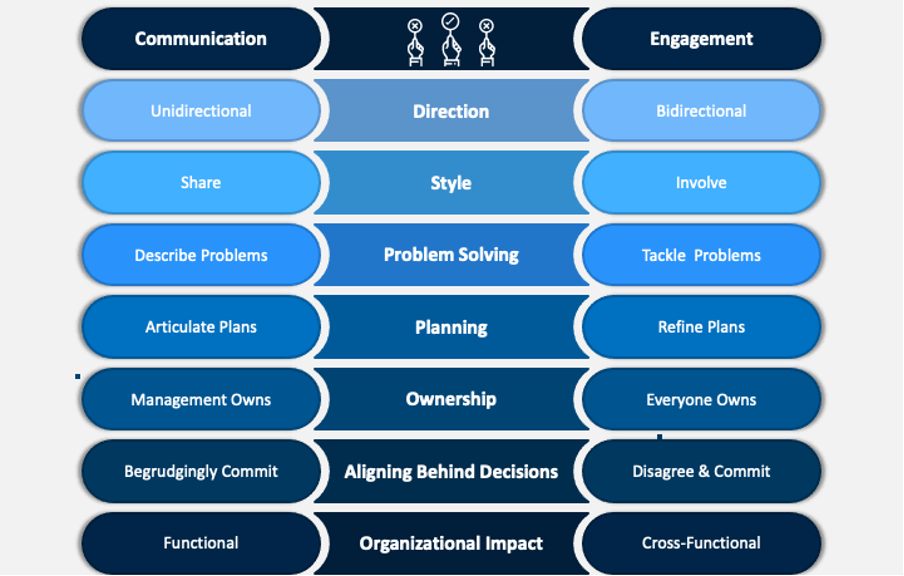Engagement for good communication
20 June 2022
Good Governance Institute engagement consultant Daniel Taylor (mCIPR) on why the recipe for good communication is engagement, and what that means for boards and communications leads.
“The single biggest problem in communication is the illusion that it has taken place.”
- George Bernard Shaw
This is one of the most often cited quotes about communication and for good reason: it remains profoundly true. I would, however, add to it: “or the perception that it doesn’t need to.”
The quote, which could just as easily bear Wittgenstein’s name, operates on two relative levels of meaning because of the clever use of the word illusion:
- It wasn’t communicated at all (for various reasons – presumption of understanding or knowledge, deemed obvious, complacency, fear, misunderstanding or the purpose of / need for communication, oversight)
- It wasn’t communicated well (Wittgensteinian point about the impossibility of true communication aside – the communication used jargonistic of esoteric language, time wasn’t taken to understand the audience, the wrong channels were used, it went out at the wrong time, etc.)
The root causes of bad communication are often simple. So too the resolutions.
Engagement is key to good communication
So how can boards, communications leads, communications teams and each and every one of us – because we all have a responsibility for communication, we are all messengers - tackle the problem of illusionary communication?
By engaging.
Engagement is a good remedy for the issue of illusionary communication because it is two-way, it builds from process of listening and talking to the recipient of the messaging. Done well it helps ensure messengers understand:
- When communication is needed
- How things need to be communicated so they will be best understood by an individual or group
- And it can provide assurance that the communication has taken place, has been understood, through the feedback that is inherent to it as an activity
Engagement should be the way in which we communicate with key stakeholders, internal and external, if we want communication to be effective.

Good communication is critical to organisational success
Good communication is essential to the success of any organisation. It helps build strong, inclusive, resilient, collaborative organisations. It is the foundation for an effective culture and the means by which relationships are developed and maintained and trust is formed. And engagement is essential to good communication.
It is also an ever-present reason when things go wrong. So many moments of organisational failure are due to poor communication – be it badly executed or lacking entirely. There is a strong and very real correlation between performance and communication both at micro and macro level.
Effective external communication is built on good internal communication
Internal and external communication and engagement are different practices but they share common DNA. It is unusual but not uncommon to have an organisation that is good at one of internal or external communication but not both. Where this is the case, it is often because of neglect of one over the other rather than anything else and often it is internal communications that gets neglected.
And yet good internal communication is the bedrock of good external communication. Setting the right culture and applying good practice internally creates the best platform for engaging with stakeholders beyond the organisation.
The role of Boards
Boards are ultimately responsible in their organisations for ensuring that good communication – and therefore engagement – are prioritised and practiced. They set the tone.
Organisations that communicate well – internally and externally – have Boards that understand the value of it and are proactive in ensuring it. What this often means in practice is that they establish communication and engagement as a core organisational value and cultural trait and often also develop principles which they role model and actively ensure are applied unilaterally in how the organisation interacts with its stakeholders.
Questions for Boards
- Are we assured that communication with our key stakeholders is taking place and is effective?
- Do we understand our duties and responsibilities around communication?
- How are we shaping the organisational culture around communication and engagement?
- What are we doing to role model the expectations we have for effective communication?
- Do we understand and have we recorded the risks to the organisation of poor communication and a poor culture of engagement?
If Board’s steer and set the culture around communication and engagement, communications leads and their team’s row. They are the engine room implementing, managing, monitoring and maintaining standards and execution. Communications and engagement teams working in organisations with agreed principles as a guide for consistent good practice and with a Board that understands, champions and demonstrate have a far easier job. Where they don’t they should be working with their Board to establish guiding principles or some sort of consistent framework that can be applied and to encourage the board to champion and role model good practice.
Benchmarking and improving
GGI has developed a new internal stakeholder engagement maturity matrix which outlines seven key elements of communicating, engaging and building relationships with internal stakeholders.
This practical tool enables Boards and communications teams to identify their current level of progress against key competencies, to determine where they want to get to in the next 12 months and how to get there.
It can be used for whole organisations or for specific programmes of work and aligns with public, third and private sector organisations. It provides clear steps on how to progress and improve in each of these areas outlined.
The core elements for assessment are:
- internal stakeholder identification and segmentation
- relationship development and management
- systems, processes and procedures
- culture
- influence
- skills and capacity
- feedback and improvement.
GGI provides specialist engagement support. If you’re interested in how we can help improve your organisation’s engagement, start a conversation with us.
Contact advice@good-governance.org.uk
